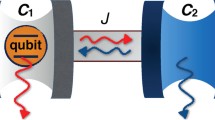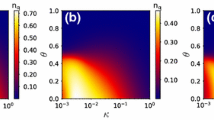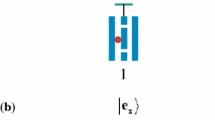Abstract
Combating the detrimental effects of noise remains a major challenge in realizing a scalable quantum computer. To help to address this challenge, we introduce a model realizing a controllable qubit-bath coupling using a sequence of LC resonators. The model establishes a strong coupling to a low-temperature environment which enables us to lower the effective qubit temperature making ground state initialization more efficient. The operating principle is similar to that of a recently proposed coplanar-waveguide cavity (CPW) system, for which our work introduces a complementary and convenient experimental realization. The lumped-element model utilized here provides an easily accessible theoretical description. We present analytical solutions for some experimentally feasible parameter regimes and study the control mechanism. Finally, we introduce a mapping between our model and the recent CPW system.





Similar content being viewed by others
Notes
When \(C_{E}, C_{c}, C_{q} \ll \tilde{C}_{L}, \tilde{C}_{R}, C_{J}\), Eq. (2) can be rewritten using the operators for charge \(\hat{Q}_{k} = C_{k} \hat{V}_{k}\) and magnetic flux \(\hat{\varPhi}_{k} = L_{k} \hat{I}_{k}\) of the kth LC resonator. These operators are canonically conjugate fulfilling the commutation relation \([\hat{Q}_{k},\hat{\varPhi}_{k}] = i\hbar\).
The resonator-resistor coupling Hamiltonian, \(\hat{H}_{\mathrm{int}}\), is determined by the operator for the voltage over C E and, hence, depends on the intrinsic voltage fluctuations \(\delta\hat{\tilde{V}}_{\mathrm{res}}\) over the resistor circuit. Accounting for the total impedance of the circuit, the spectral density of the voltage fluctuations across C E is given by \(S_{\delta\tilde{V}_{\mathrm{res}}}(\omega) = [1/(\omega C_{E})]^{2}/|R+1/(i\omega C_{E})|^{2} S_{\delta V_{\mathrm{res}}}(\omega)\), where \(S_{\delta V_{\mathrm{res}}}(\omega)\) is the spectral density of the voltage fluctuations \(\delta\hat{V}_{\mathrm{res}}\) over the resistor. In this paper, we select the system parameters such that ω≪1/(RC E ) implying that \(S_{\delta\tilde{V}_{\mathrm {res}}}(\omega) \approx S_{\delta V_{\mathrm{res}}}(\omega)\), and the Hamiltonian in Eq. (4) accurately approximates the resonator-resistor coupling. This is essentially the same approximation that is employed in writing down Eq. (1) by neglecting the terms that are of the second order in the voltage fluctuations.
When \(C_{E}, C_{c}, C_{q} \ll \tilde{C}_{L}, \tilde{C}_{R}, C_{J}\), we can define \(\hat{N} = -(C_{J} + C_{q})\hat{V}_{q}/(2e)\) as the Cooper-pair number operator for the junction transferring to a more typical presentation. The phase difference operator \(\hat{\phi}\) is canonically conjugate to \(\hat{N}\) fulfilling \([\hat{\phi},\hat{N}] = i\).
This is the method applied in this work. An alternative, more accurate choice is to include the effect of the coupling capacitance C q in both models. However, this will shift the frequencies only very slightly since typically C q is greatly smaller than the total cavity capacitance.
The mapping procedure in Appendix 3 matches the bare voltage operators at the ends of the cavity regions to the resonator voltage operators in our model. For x q ≈x cav, we can approximate the cavity-qubit coupling by adding the spatial dependence of the bare cavity voltage operator in Eq. (45) to the resonator-qubit coupling capacitance. This yields the approximate formula \(C_{q}^{\textrm{eff}} = C_{q}^{0} \cos[\pi(x_{q}-x_{\textrm {cav}})/(x_{\textrm{cav}}-x_{c})]\). As the coupling is to the actual cavity modes, the approximation becomes less accurate when the qubit is positioned further from the end of the cavity.
References
W.G. Unruh, Phys. Rev. A 51, 992 (1995)
A.M. Steane, Nature (London) 399, 124 (1999)
T.D. Ladd, F. Jelezko, R. Laflamme, Y. Nakamura, C. Monroe, J.L. O’Brien, Nature (London) 464, 45 (2010)
J.Q. You, F. Nori, Phys. Rev. B 68, 064509 (2003)
A. Blais, R.S. Huang, A. Wallraff, S.M. Girvin, R.J. Schoelkopf, Phys. Rev. A 69, 062320 (2004)
A. Wallraff, D.I. Schuster, A. Blais, L. Frunzio, R.-S. Huang, J. Majer, S. Kumar, S.M. Girvin, R.J. Schoelkopf, Nature (London) 431, 162 (2004)
J.Q. You, F. Nori, Phys. Today 58, 42 (2005)
J.Q. You, F. Nori, Nature (London) 474, 589 (2011)
A. Blais, J. Gambetta, A. Wallraff, D.I. Schuster, S.M. Girvin, M.H. Devoret, R.J. Schoelkopf, Phys. Rev. A 75, 032329 (2007)
D.I. Schuster, A.A. Houck, J.A. Schreier, A. Wallraff, J.M. Gambetta, A. Blais, L. Frunzio, J. Majer, B. Johnson, M.H. Devoret, S.M. Girvin, R.J. Schoelkopf, Nature (London) 445, 515 (2007)
L. DiCarlo, J.M. Chow, J.M. Gambetta, L.S. Bishop, B.R. Johnson, D.I. Schuster, J. Majer, A. Blais, L. Frunzio, S.M. Girvin, R.J. Schoelkopf, Nature (London) 460, 240 (2009)
J. Clarke, F.K. Wilhelm, Nature (London) 453, 1031 (2008)
I. Buluta, F. Nori, Science 326, 108 (2009)
I. Buluta, S. Ashhab, F. Nori, Rep. Prog. Phys. 74, 104401 (2011)
T. Niemczyk, F. Deppe, H. Huebl, E.P. Menzel, F. Hocke, M.J. Schwarz, J.J. Garcia-Ripoll, D. Zueco, T. Huemmer, E. Solano, A. Marx, R. Gross, Nat. Phys. 6, 772 (2010)
Z.-L. Xiang, S. Ashhab, J.Q. You, F. Nori, Rev. Mod. Phys. 85, 623 (2013)
H. Paik, D.I. Schuster, L.S. Bishop, G. Kirchmair, G. Catelani, A.P. Sears, B.R. Johnson, M.J. Reagor, L. Frunzio, L.I. Glazman, S.M. Girvin, M.H. Devoret, R.J. Schoelkopf, Phys. Rev. Lett. 107, 240501 (2011)
M.H. Devoret, R.J. Schoelkopf, Science 339, 1169 (2013)
J. Koch, T.M. Yu, J. Gambetta, A.A. Houck, D.I. Schuster, J. Majer, A. Blais, M.H. Devoret, S.M. Girvin, R.J. Schoelkopf, Phys. Rev. A 76, 042319 (2007)
V.E. Manucharyan, J. Koch, L.I. Glazman, M.H. Devoret, Science 326, 113 (2009)
P. Nataf, C. Ciuti, Phys. Rev. Lett. 107, 190402 (2011)
P.J. Jones, J.A.M. Huhtamäki, K.Y. Tan, M. Möttönen, Phys. Rev. B 85, 075413 (2012)
P.J. Jones, J.A.M. Huhtamäki, M. Partanen, K.Y. Tan, M. Möttönen, Phys. Rev. B 86, 035313 (2012)
P.J. Jones, J.A.M. Huhtamäki, J. Salmilehto, K.Y. Tan, M. Möttönen, Sci. Rep. 3, 1987 (2013)
J.E. Johnson, C. Macklin, D.H. Slichter, R. Vijay, E.B. Weingarten, J. Clarke, I. Siddiqi, Phys. Rev. Lett. 109, 050506 (2012)
D. Ristè, J.G. van Leeuwen, H.-S. Ku, K.W. Lehnert, L. DiCarlo, Phys. Rev. Lett. 109, 050507 (2012)
M.D. Reed, B.R. Johnson, A.A. Houck, L. DiCarlo, J.M. Chow, D.I. Schuster, L. Frunzio, R.J. Schoelkopf, Appl. Phys. Lett. 96, 203110 (2010)
D. Pozar, Microwave Engineering (Wiley, Hoboken, 2004)
J.T. Muhonen, M. Meschke, J.P. Pekola, Rep. Prog. Phys. 75, 046501 (2012)
F. Giazotto, T.T. Heikkilä, A. Luukanen, A.M. Savin, J.P. Pekola, Rev. Mod. Phys. 78, 217 (2006)
S.O. Valenzuela, W.D. Oliver, D.M. Berns, K.K. Berggren, L.S. Levitov, T.P. Orlando, Science 314, 1589 (2006)
J.Q. You, Y.-x. Liu, F. Nori, Phys. Rev. Lett. 100, 047001 (2008)
M. Grajcar, S. Ashhab, J.R. Johansson, F. Nori, Phys. Rev. B 78, 035406 (2008)
M. Grajcar, S.H.W. van der Ploeg, A. Izmalkov, E. Il’ichev, H.-G. Meyer, A. Fedorov, A. Shnirman, G. Schön, Nat. Phys. 4, 612 (2008)
A.O. Caldeira, A.J. Leggett, Phys. Rev. Lett. 46, 211 (1981)
B. Yurke, J.S. Denker, Phys. Rev. A 29, 1419 (1984)
D. Vion, A. Aassime, A. Cottet, P. Joyez, H. Pothier, C. Urbina, D. Esteve, M.H. Devoret, Science 296, 886 (2002)
A.A. Clerk, M.H. Devoret, S.M. Girvin, F. Marquardt, R.J. Schoelkopf, Rev. Mod. Phys. 82, 1155 (2010)
P. Horowitz, W. Hill, The Art of Electronics (Cambridge University Press, New York, 1989)
Acknowledgements
We acknowledge the Väisälä Foundation and the Finnish National Doctoral Programme in Materials Physics (NGSMP) for financial support. This research has been supported by the Academy of Finland through its Centres of Excellence Program under Grant No. 251748 (COMP) in addition to the Grants No. 138903 and No. 135794. We have received funding from the European Research Council under Starting Independent Researcher Grant No. 278117 (SINGLEOUT).
Author information
Authors and Affiliations
Corresponding author
Appendices
Appendix 1: Analytical Solution to the Energy Eigenproblem
In the low-energy regime and within the rotating-wave approximation, the time-independent Schrödinger equation \((\hat{H}_{L} + \hat{H}_{R} + \hat{H}_{L-R} + \hat{H}_{q} + \hat{H}_{R-q})|\varphi_{k}\rangle = \epsilon_{k} |\varphi_{k}\rangle \), where k∈{0,1,2,3}, has a ground state given by |φ 0〉=|0,0,g〉. See Eqs. (2)–(9) for definitions of the Hamiltonians. We select the zero-point energy such that ϵ 0=0. After rewriting the above Hamiltonian in the basis described in Sect. 3.2, the eigenproblem reduces to solving three simultaneous equations



where \(\epsilon'_{k} = \epsilon_{k}/\hbar\). The equations yield the eigenenergies ϵ k , k=1,2,3, and, similarly, solving γ k and θ k produces the excited states as |φ k 〉=sin(θ k )|1,0,g〉+cos(θ k )sin(γ k )|0,1,g〉+cos(θ k )cos(γ k )|0,0,e〉.
Appendix 2: Weak-Coupling Limit
Let us rewrite the total Hamiltonian of the resonator-qubit system [see Eqs. (2)–(9) for definitions] ignoring the resistor as \(\hat{H}_{\mathrm{sys}} = \hat{H}_{L} + \hat{H}_{R} + \hat{H}_{q} + \hat{H}'\), where \(\hat{H}' = \hat{H}_{L-R} + \hat{H}_{R-q}\) is the small perturbation in the weak coupling limit |α|,|g|≪ω L ,ω R ,ω q and the system is far away from resonance |α|,|g|≪|ω l −ω s |, for all l,s∈{L,R,q}. The ground state is unaffected by the perturbation and given by |φ 0〉=|0,0,g〉 with its eigenenergy selected as the zero-point of energy. After applying the second-order perturbation theory in the small coupling parameters, the eigenenergies of \(\hat {H}_{\mathrm{sys}}\) are given by



where we adopted the notation Δ ls =ω l −ω s for the difference between two intrinsic system frequencies. The corresponding eigenstates are
and the normalization constants are given by



Appendix 3: Bare Mode Mapping
If we omit the coupling capacitor inserted into the CPW cavity shown in Fig. 3, the cavity regions can be treated as individual resonators. We denote these resonators as bare cavities and write the excitation frequencies for their lowest-energy modes as [28]


where c is the constant cavity capacitance per unit length, ℓ L (ℓ R ) is the left (right) cavity inductance per unit length, x c is the position of the dividing capacitor C c in the central conducting strip of the cavity and x cav is the length of the cavity. Similarly, the voltage operators for these modes are given by


where \((\hat{a}_{l}^{b})^{\dagger}\) and \(\hat{a}_{l}^{b}\), l=L,R, are the creation and annihilation operators for the modes, respectively. The prefactors for the operators are \(V_{L}^{b0} = \sqrt{\hbar\omega _{L}^{b}/(x_{c} c)}\) and \(V_{R}^{b0} = \sqrt{\hbar\omega_{R}^{b}/[(x_{\mathrm{cav}}-x_{c}) c]}\).
We relate the bare cavities to our resonator system in Fig. 1 by demanding that \(\omega_{L} = \omega_{L}^{b}\), \(\omega_{R} = \omega_{R}^{b}\), \(V_{L}^{b0} = V_{L}^{0}\) and \(V_{R}^{b0} = V_{R}^{0}\). This causes the resonators in our system and the bare cavities to have equal excitation energies, and the prefactors of the voltage operators at the ends of the bare cavities to match the prefactors of the voltage operators in our system. The resulting mapping is given in Eqs. (26)–(29). Matching the voltage operators in this manner ensures that including the same coupling capacitors into both systems has the same effect on the spectrum. This is because the bare mode voltages at the coupling capacitor effectively determine its charging Hamiltonian.
Rights and permissions
About this article
Cite this article
Jones, P.J., Salmilehto, J. & Möttönen, M. Highly Controllable Qubit-Bath Coupling Based on a Sequence of Resonators. J Low Temp Phys 173, 152–169 (2013). https://doi.org/10.1007/s10909-013-0889-3
Received:
Accepted:
Published:
Issue Date:
DOI: https://doi.org/10.1007/s10909-013-0889-3




